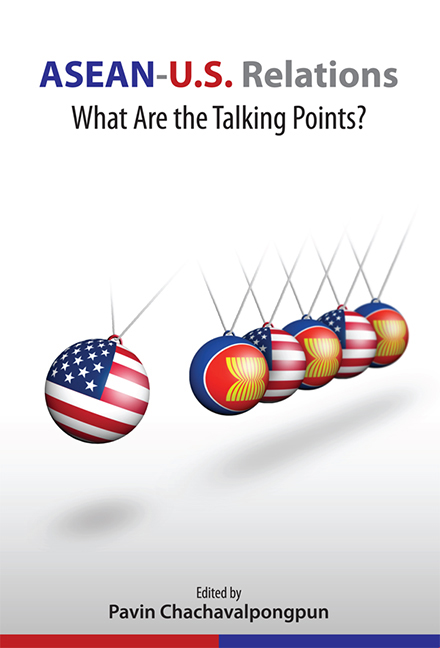Book contents
- Frontmatter
- Contents
- List of Tables and Figures
- Preface
- Contributors
- List of Abbreviations
- OVERVIEW
- 1 U.S. Engagement with ASEAN
- 2 ASEAN-U.S. Relations
- 3 Developments in ASEAN-U.S. Relations
- 4 The United States, Russia to be Part of East Asia Summit
- 5 How Does the United States Play into the East Asia Summit for ASEAN?
- QUINTESSENTIAL ISSUES
- Index
2 - ASEAN-U.S. Relations
from OVERVIEW
Published online by Cambridge University Press: 21 October 2015
- Frontmatter
- Contents
- List of Tables and Figures
- Preface
- Contributors
- List of Abbreviations
- OVERVIEW
- 1 U.S. Engagement with ASEAN
- 2 ASEAN-U.S. Relations
- 3 Developments in ASEAN-U.S. Relations
- 4 The United States, Russia to be Part of East Asia Summit
- 5 How Does the United States Play into the East Asia Summit for ASEAN?
- QUINTESSENTIAL ISSUES
- Index
Summary
ASEAN has come a long way since its inception, and even since I was last working in Malaysia in the early 1990s. ASEAN has taken on an increasingly broad role in a wide array of regional and global issues, and the United States is determined to support ASEAN in its endeavours. We are committed to this area, and look forward to working with the organization even more closely in the coming years.
Back in 1967, when ASEAN was founded, there were only five members and the region was beset with serious differences and even conflict, but even then, the organization was key to bringing peace and stability to the region, offering a forum to discuss issues harmoniously. Today's ASEAN is ten members strong, at peace, and has formal relationships with many countries, and also with international organizations, including the United Nations and the G-20. ASEAN has become the centrepiece of the construction of a regional architecture in the Asia-Pacific region, a central role that the United States supports.
The United States is fully committed to working with ASEAN. A prosperous and peaceful Southeast Asia has always been in our own interest, and ASEAN is and will continue to be the linchpin in bringing that vision to fruition. As ASEAN has changed over the years, so has our relationship. The United States has had a formal relationship with ASEAN since 1977, when the first ASEAN-U.S. Dialogue took place. Early discussions were focused primarily on economic issues, including trade and development. We have since added new areas for discussion, but the economic side remains a central part of our relationship, and I would like to highlight that.
Needless to say, trade holds a special place in the relationship. ASEAN members have pursued successful economic growth strategies centred on exports, many of which are destined for the 300-million-plus consumer market in the United States. The region's rapid economic development these past decades is a testament to the benefits of open trade. But the region is an important market for us as well, with over US$53 billion in our exports going to ASEAN countries last year. Taken together, the ASEAN countries are our fourth-largest export market. The Trade and Investment Framework Arrangement (TIFA) that we signed with ASEAN in 2006 has helped keep trade flowing.
- Type
- Chapter
- Information
- ASEAN-U.S. RelationsWhat Are the Talking Points?, pp. 6 - 9Publisher: ISEAS–Yusof Ishak InstitutePrint publication year: 2011



